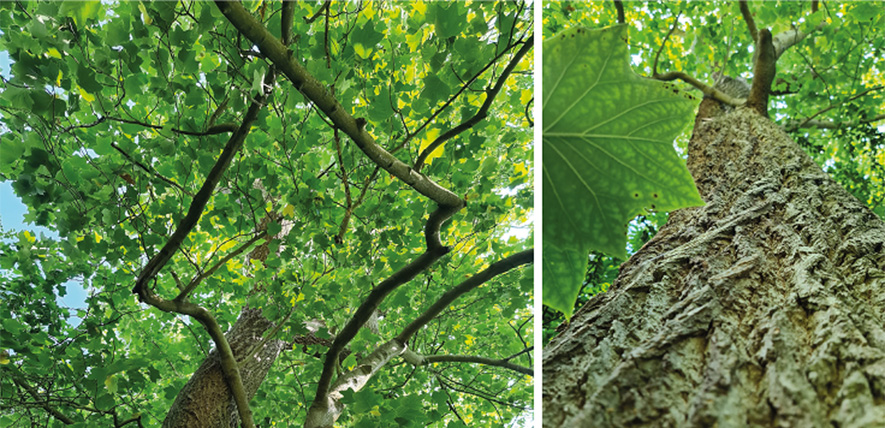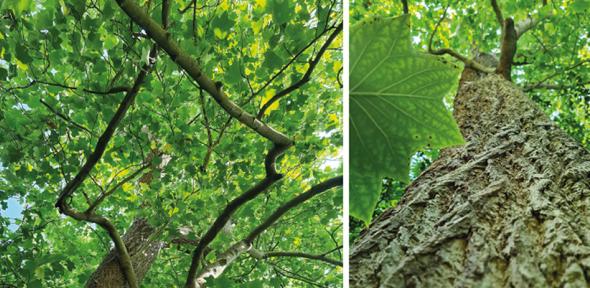
Scientists from the Sainsbury Laboratory Cambridge University and Jagiellonian University, Poland made the discovery while undertaking an evolutionary survey of the microscopic structure of wood from some of the world’s most iconic trees and shrubs.
They found that Tulip Trees, which are related to magnolias and can grow over 100 feet tall, have a unique type of wood. This discovery may explain why the trees, which diverged from magnolias when earth’s atmospheric CO2 concentrations were relatively low, grow so tall and so fast. This opens new opportunities to improve carbon capture and storage in plantation forests by planting a fast-growing tree more commonly seen in ornamental gardens, or breeding Tulip Tree-like wood into other tree species.
The discovery was part of an evolutionary survey of the microscopic structure of wood from 33 tree species from the Cambridge University Botanic Garden’s Living Collections. The survey explored how wood ultrastructure evolved across softwoods (gymnosperms such as pines and conifers) and hardwoods (angiosperms including oak, ash, birch, and eucalypts).
The wood samples were collected from trees in the Botanic Garden in coordination with its Collections Coordinator. Fresh samples of wood, deposited in the previous spring growing season, were collected from a selection of trees to reflect the evolutionary history of gymnosperm and angiosperm populations as they diverged and evolved.
Using the Sainsbury Laboratory’s low temperature scanning electron microscope (cryo-SEM), the team imaged and measured the size of the nanoscale architecture of secondary cell walls (wood) in their native hydrated state.
Microscopy Core Facility Manager at the Sainsbury Laboratory, Dr Raymond Wightman, said: “We analysed some of the world’s most iconic trees like the Coast Redwood, Wollemi Pine and so-called “living fossils” such as Amborella trichopoda, which is the sole surviving species of a family of plants that was the earliest still existing group to evolve separately from all other flowering plants.
“Our survey data has given us new insights into the evolutionary relationships between wood nanostructure and the cell wall composition, which differs across the lineages of angiosperm and gymnosperm plants. Angiosperm cell walls possess characteristic narrower elementary units, called macrofibrils, compared to gymnosperms.”
The researchers found the two surviving species of the ancient Liriodendron genus, commonly known as the Tulip Tree (Liriodendron tulipifera) and Chinese Tulip Tree (Liriodendron chinense) have much larger macrofibrils than their hardwood relatives.
Hardwood angiosperm macrofibrils are about 15 nanometres in diameter and faster growing softwood gymnosperm macrofibrils have larger 25 nanometre macrofibrils. Tulip Trees have macrofibrils somewhere in between, measuring 20 nanometres.
Lead author of the research published in New Phytologist, Dr Jan Łyczakowski from Jagiellonian University, said: “We show Liriodendrons have an intermediate macrofibril structure that is significantly different from the structure of either softwood or hardwood. Liriodendrons diverged from Magnolia Trees around 30-50 million years ago, which coincided with a rapid reduction in atmospheric CO2. This might help explain why Tulip Trees are highly effective at carbon storage.”
The team suspect it is the larger macrofibrils in this “midwood” or “accumulator-wood” that is behind the Tulip Trees’ rapid growth.
Łyczakowski added: “Both Tulip Tree species are known to be exceptionally efficient at locking in carbon, and their enlarged macrofibril structure could be an adaptation to help them more readily capture and store larger quantities of carbon when the availability of atmospheric carbon was being reduced. Tulip Trees may end up being useful for carbon capture plantations. Some east Asian countries are already using Liriodendron plantations to efficiently lock in carbon, and we now think this might be related to its novel wood structure.”
Liriodendron tulipifera are native to northern America and Liriodendron chinense is a native species of central and southern China and Vietnam.
Łyczakowski said: “Despite its importance, we know little about how the structure of wood evolves and adapts to the external environment. We made some key new discoveries in this survey – an entirely novel form of wood ultrastructure never observed before and a family of gymnosperms with angiosperm-like hardwood instead of the typical gymnosperm softwood.
“The main building blocks of wood are the secondary cell walls, and it is the architecture of these cell walls that give wood its density and strength that we rely on for construction. Secondary cell walls are also the largest repository of carbon in the biosphere, which makes it even more important to understand their diversity to further our carbon capture programmes to help mitigate climate change.”
This research was funded by the National Science Centre Poland and The Gatsby Charitable Foundation.
Reference: Lyczakowski, J.L. and Wightman, R. “Convergent and adaptive evolution drove change of secondary cell wall ultrastructure in extant lineages of seed plants.” July 2024, New Phytologist. DOI: 10.1111/nph.19983
All cryo-SEM images from the wood survey are publicly available here.
Read more about this research.
“The University of Cambridge is a public collegiate research university in Cambridge, England. Founded in 1209, the University of Cambridge is the third-oldest university in continuous operation.”
Please visit the firm link to site






